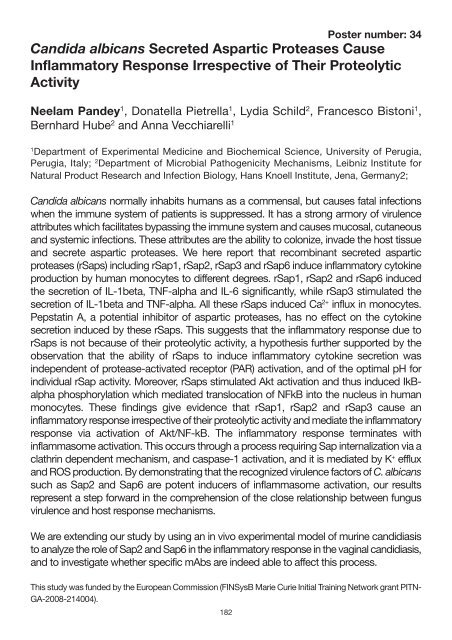Candida Infection Biology – fungal armoury, battlefields ... - FINSysB
Candida Infection Biology – fungal armoury, battlefields ... - FINSysB
Candida Infection Biology – fungal armoury, battlefields ... - FINSysB
You also want an ePaper? Increase the reach of your titles
YUMPU automatically turns print PDFs into web optimized ePapers that Google loves.
Poster number: 34<br />
<strong>Candida</strong> albicans Secreted Aspartic Proteases Cause<br />
Inflammatory Response Irrespective of Their Proteolytic<br />
Activity<br />
Neelam Pandey 1 , Donatella Pietrella 1 , Lydia Schild 2 , Francesco Bistoni 1 ,<br />
Bernhard Hube 2 and Anna Vecchiarelli 1<br />
1 Department of Experimental Medicine and Biochemical Science, University of Perugia,<br />
Perugia, Italy; 2 Department of Microbial Pathogenicity Mechanisms, Leibniz Institute for<br />
Natural Product Research and <strong>Infection</strong> <strong>Biology</strong>, Hans Knoell Institute, Jena, Germany2;<br />
<strong>Candida</strong> albicans normally inhabits humans as a commensal, but causes fatal infections<br />
when the immune system of patients is suppressed. It has a strong armory of virulence<br />
attributes which facilitates bypassing the immune system and causes mucosal, cutaneous<br />
and systemic infections. These attributes are the ability to colonize, invade the host tissue<br />
and secrete aspartic proteases. We here report that recombinant secreted aspartic<br />
proteases (rSaps) including rSap1, rSap2, rSap3 and rSap6 induce inflammatory cytokine<br />
production by human monocytes to different degrees. rSap1, rSap2 and rSap6 induced<br />
the secretion of IL-1beta, TNF-alpha and IL-6 significantly, while rSap3 stimulated the<br />
secretion of IL-1beta and TNF-alpha. All these rSaps induced Ca 2+ influx in monocytes.<br />
Pepstatin A, a potential inhibitor of aspartic proteases, has no effect on the cytokine<br />
secretion induced by these rSaps. This suggests that the inflammatory response due to<br />
rSaps is not because of their proteolytic activity, a hypothesis further supported by the<br />
observation that the ability of rSaps to induce inflammatory cytokine secretion was<br />
independent of protease-activated receptor (PAR) activation, and of the optimal pH for<br />
individual rSap activity. Moreover, rSaps stimulated Akt activation and thus induced IkBalpha<br />
phosphorylation which mediated translocation of NFkB into the nucleus in human<br />
monocytes. These findings give evidence that rSap1, rSap2 and rSap3 cause an<br />
inflammatory response irrespective of their proteolytic activity and mediate the inflammatory<br />
response via activation of Akt/NF-kB. The inflammatory response terminates with<br />
inflammasome activation. This occurs through a process requiring Sap internalization via a<br />
clathrin dependent mechanism, and caspase-1 activation, and it is mediated by K + efflux<br />
and ROS production. By demonstrating that the recognized virulence factors of C. albicans<br />
such as Sap2 and Sap6 are potent inducers of inflammasome activation, our results<br />
represent a step forward in the comprehension of the close relationship between fungus<br />
virulence and host response mechanisms.<br />
We are extending our study by using an in vivo experimental model of murine candidiasis<br />
to analyze the role of Sap2 and Sap6 in the inflammatory response in the vaginal candidiasis,<br />
and to investigate whether specific mAbs are indeed able to affect this process.<br />
This study was funded by the European Commission (<strong>FINSysB</strong> Marie Curie Initial Training Network grant PITN-<br />
GA-2008-214004).<br />
182


